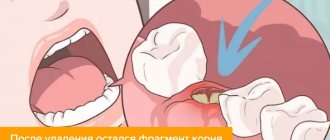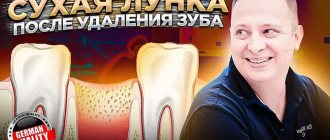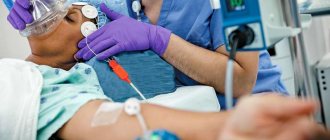Author: Trofimov Andrey Yurievich
What to do after tooth extraction? Every person has gone through this procedure in their life. Doctors always give recommendations, but more often than not, after the pain relief wears off, every second patient forgets about what was told to him in the dental chair. In most cases, after the anesthesia wears off, the pain returns with a vengeance. What should you do if after tooth extraction there is bleeding, the socket, gums become inflamed, or swelling occurs? How to avoid infection and a repeat unpleasant trip to the dentist?
General recommendations
Important restrictions after tooth extraction
Taking medications after tooth extraction
What else should you do after tooth extraction?
Hygiene rules after tooth extraction
What is normal after tooth extraction?
General recommendations
The most important rule in such a sensitive issue will be timely assistance from a qualified specialist. Therefore, if your tooth suddenly starts to hurt badly, this is not a reason to just take a pill and forget about this unpleasant moment, this is a good reason to go to a dental clinic, where you will be given first aid.
With any removal, complex or ordinary, there are a number of rules that must be followed to speed up the healing of the wound, as well as avoid abscesses and other negative consequences.
- Removing the gauze compress. The doctor leaves cotton wool or gauze after tooth extraction. A maximum of one hour after arriving from the dentist, you must carefully remove the protective swab. If it has dried out and stuck to the gum, do not remove it until you soak the area with chlorhexidine, since careless movement can damage or even remove the clot hiding the wound.
- Pain relief. Any discomfort after tooth extraction is a normal process for which you need to be prepared. Ice or any cool item from the refrigerator will help relieve discomfort. The selected item is wrapped in a towel and applied to the sore cheek. In addition to relieving pain, this action will help reduce the chances of swelling. However, this action also has its limitations: ice can be applied several times, making sure to take a break of 5-7 minutes.
- Eating. In the first few hours after tooth extraction, be it a molar or a chewing tooth, you should not eat any food, even if you are very hungry. Over the next 24 hours, the temperature of the food should only be at room temperature. Food should not be too spicy or salty, this can cause additional irritation of the mucous membrane.
- Limit alcohol and smoking. On the first day after tooth extraction, you should refrain from drinking alcoholic beverages. Even a small dose of alcohol can cause blood vessels to dilate, which will ultimately lead to bleeding from the wound. Smoking is permissible, but again at least 2-3 hours after the operation.
- Applying and removing sutures. If sutures were placed at the dental clinic after tooth extraction, the patient is usually invited for a follow-up appointment in a week. In some cases, the sutures dissolve on their own within two weeks.
- Dental treatment. For those who are now closely involved in treating the entire oral cavity, a reasonable question arises: when can the procedures be continued? If the removal was not difficult, then it will be possible to resume meetings with your doctor after 7 days.
Preservation of the hole - a necessity or a new trend?
Preservation of the socket - filling the cavity formed after tooth extraction with osteogenic material - is a very important component of dental treatment after tooth extraction.
This technique completely prevents bone resorption, which is known to be 25% already in the first year, which means that within 3 years the loss of bone volume can be 60%.
Preservation of the socket not only stops this process, but also preserves the gingival contour without gaps and prepares the gingival bone for future unhindered implant installation.
It is important that conservation ensures the correct load on the bone tissue, which means that at the time of implantation the condition of the bone will be exactly what is necessary for installing the implant without prior bone grafting.
Thus, preserving the socket after tooth extraction will not only save the patient from additional bone-building surgery, but will also save a considerable amount, because bone grafting is not the cheapest dental operation.
Important restrictions after tooth extraction
Each patient, in addition to recommendations, should also know what not to do:
- Visit the bathhouse, sauna or swimming pools. Experts also recommend limiting yourself to a short period of time by taking a shower rather than a hot bath.
- Go to the gym and take on heavy physical activity;
- Experiencing stress, which, oddly enough, can seriously affect the wound and even contribute to the opening of bleeding;
- Get into the mouth, in the wound area with dirty hands;
- Touch the site of tooth extraction, be it the tongue or fingers, because this will certainly lead to damage to the clot;
- Brush the removal area with a toothbrush;
- Actively rinse your mouth, because any aggressive external actions can lead to clot disruption and the development of alveolitis.
It is worth noting that representatives of the fair half of humanity are not recommended to remove teeth during the menstrual cycle, because this will only provoke bleeding from the resulting wound.
Causes of ichor after tooth extraction
Associated factors influencing the duration of ichor discharge after tooth extraction:
- damage to blood vessels;
- inflammatory reaction in damaged tissues;
- hypertensive crisis;
- poor blood clotting indicators.
When a patient has hypertension, the risk of severe bleeding from the site of the extracted tooth increases. This is due to taking medications that lead to blood thinning. Experts recommend stopping taking such medications a couple of days before the planned surgery.
Also a dangerous factor is the presence of low blood clotting in the patient. In this case, it is recommended to take a course of sedatives to prevent surges in blood pressure.
Taking medications after tooth extraction
Experienced specialists recommend taking antihistamines. They will help avoid swelling of the cheeks, because in addition to working on allergic reactions, antihistamines also have an anti-edematous effect.
You should not overdo it with medications if the pain is tolerable and tooth extraction was a procedure of ordinary complexity. A little trick that can be remembered for the future is to take an analgesic even before the patient stops feeling the anesthesia administered by the doctor.
As for antibiotics, it is strictly not recommended to take them without a corresponding prescription from the attending physician. In what cases does the surgeon issue a referral for the purchase of necessary medications:
- for difficult removal;
- with the development of the inflammatory process;
- in case of concomitant diseases such as stomatitis or candidiasis.
Alveolitis after tooth extraction: symptoms
As for the general symptoms, since alveolitis is not an acute inflammatory process, it usually does not cause fever or inflammation of the submandibular lymph nodes. However, when it lasts for a long time, patients often feel weakness, fatigue, and the temperature may rise (but not higher than 37.5 degrees).
- Patient complaints include aching or throbbing pain in the area of the extracted tooth socket (of varying severity - from moderate to severe).
Sometimes alveolar pain can also spread to other areas of the head and neck. When alveolitis develops, pain usually occurs 2-4 days after removal, and can last from 10 to 40 days - in the absence of qualified treatment. Sometimes the pain is so severe that even very strong analgesics do not help. In addition, almost all patients report bad breath and an unpleasant taste in the mouth.
- When visually examining the socket, you can see an empty socket in which there is no blood clot (in this case, the alveolar bone in the depths of the socket will be exposed).
Or the socket may be completely or partially filled with food debris or necrotic disintegration of a blood clot. By the way, if the alveolar bone is exposed, it is usually extremely painful when touched, as well as when in contact with cold or hot water. In some cases, the edges of the mucous membrane converge so closely to each other above the hole that it is completely impossible to see what is happening in its depths. But when washing such a hole from a syringe with an antiseptic, the liquid will be cloudy, with a lot of food residue.
Dry socket after wisdom tooth removal –
Alveolitis after wisdom tooth removal may in addition have several more symptoms (in addition to those listed above). We are talking about difficulty opening the mouth or painful swallowing (24stoma.ru). Also, due to the fact that the socket of the 8th tooth is usually located deep in the soft tissues, suppuration from the socket often develops there (see video 2).
Alveolitis: video
In video 1 below you can see that there is no blood clot in the socket, there is exposed bone, and also in the depths of the socket it is filled with food debris. And in video 2 - alveolitis of the lower wisdom teeth, when the patient presses his finger on the gum in the area of 7-8 teeth, and copious purulent discharge comes from the holes.
Hygiene rules after tooth extraction
The first and important rule will be to limit brushing and rinsing your teeth immediately after surgery. You can start your usual lifestyle with daily brushing of your teeth the next day.
It is worth purchasing a brush with soft bristles at a pharmacy or store in advance, but it is still necessary to clean the area of removal with special care. Irrigator and dental floss are not allowed.
Hole hygiene deserves special attention. Dental surgeons recommend the following method for care:
- take a herbal decoction or a special rinse purchased at the pharmacy into the oral cavity;
- hold it in your mouth for several minutes, without performing any additional actions such as rolling water;
- After cleansing, you should try to refrain from drinking water and food for a couple of hours.
This action will help to avoid inflammatory processes in and around the hole, and will also reduce bleeding. Baths based on an antiseptic, for example, water-based chlorhexidine or furatsilin, will be effective.
Alarming symptoms
If the hole turns black after tooth extraction, do not put off visiting the doctor until later. It is better to immediately consult a specialist and exclude possible complications. In addition to darkening of soft tissues, reasons for visiting a dentist may be:
- severe pain in the area of the extracted tooth,
- bad breath,
- swelling of the lips or cheeks,
- continuous bleeding
- enlarged lymph nodes,
- discharge of pus from the socket,
- increase in body temperature to 38 degrees.
Treatment is aimed at eliminating the source of infection and preserving tissue. To do this, the hole is cleaned of the accumulation of pus and treated with antiseptics. To relieve pain and prevent complications, painkillers and antibacterial drugs are prescribed.
What rinses are allowed after tooth extraction?
On the second or third day after tooth extraction, you are allowed to rinse your mouth with products prescribed by the doctor. These include:
- Chlorhexidine. This disinfectant solution fights well against many microorganisms that populate the oral cavity, however, it is powerless against viruses and fungi. The main advantage of the drug is its activity in the presence of blood and pus. After using chlorhexidine, a small part of it remains on the oral mucosa, gradually being washed off with saliva and water. Thanks to this, its effect lasts for several hours. Irrigate your mouth with this product several times a day, without diluting it with water.
- Miramistin. This active antiseptic affects both gram-positive and gram-negative microorganisms that inhabit the oral cavity. In addition, it fights well against yeast-like fungi and some viruses. Improves immunity and heals wounds. Its penetration into the blood is minimal. Prescribed by a doctor if a purulent complication has begun in the tooth socket. Miramistin is completely harmless for children and pregnant women.
- Salt and soda. Effective home remedies to eliminate inflammation. Can be used for preventive purposes. To prepare the solution, take 250 ml of water and a teaspoon each of soda and salt. In addition, you can use a soda-iodine solution for rinsing. In a glass of warm water, dilute a teaspoon of soda and add 5 drops of iodine. Under no circumstances should you use hot water for rinsing, otherwise bleeding may occur.
- Furacilin. This medicine has long established itself as an excellent antiseptic. It actively fights pathogenic microflora of the oral cavity and is used for complications with pus after tooth extraction. To prepare the solution you need one liter of water, 10 furatsilin tablets and a teaspoon of salt. Place a container of water over low heat and bring to a boil, because furatsilin tablets dissolve very well in hot water. After they are completely dissolved, the mixture is removed from the heat and cooled. It is used for medicinal purposes 3-4 times a day.
- Potassium permanganate. Potassium permanganate has long been used in dentistry for disinfection and treatment of wounds with pus. A weak solution of potassium permanganate effectively relieves the inflammatory process in purulent wounds. To prepare a 0.1% solution of potassium permanganate, you need to take 1 gram of potassium permanganate and dissolve it in 1 liter of warm water. The result should be a slightly pink solution. A stronger concentration of potassium permanganate can cause a burn to the mucous membrane, as well as provoke allergic reactions.
- Herbal decoctions are good for relieving swelling and inflammation after surgery. You can use chamomile, eucalyptus, oak bark, calendula, and sage leaves. To prepare a decoction, pour a tablespoon of dry herb into a glass of boiling water, wait until it boils, and remove from heat. Wrap up and place in a warm place for 2 hours. The procedures must be performed after each meal.
Why you shouldn't rinse your mouth after tooth extraction
After removing a tooth, the doctor prescribes rinsing in the following cases:
- If there was an inflammatory process in the gums before surgery.
- The gum was previously opened to remove the purulent infiltrate.
- The presence of carious teeth and tartar in the oral cavity.
- The occurrence of diseases such as gingivitis, periodontitis and others in the oral cavity.
It is strictly forbidden to rinse your mouth on the first day after a tooth is removed. The thing is that after such a surgical intervention, the doctor treats the wound with hydrogen peroxide, causing bleeding, and may even apply stitches. This is a guarantee that complications will not arise in the future. A clot forms in the socket, protecting it from the penetration of harmful microbes, which are located in large numbers in the oral cavity. The most important thing is that this blood clot remains in the wound longer.
Some patients, completely forgetting these doctor’s recommendations, begin to rinse the mouth with all sorts of decoctions in order to speed up healing. Nothing good comes out of this. The clot is immediately washed out, the socket and jaw bone are exposed. Microbes very quickly penetrate the wound and infect it. As a result, alveolitis develops, which also requires treatment, and a serious disease such as osteomyelitis can develop. It is characterized by a purulent process that occurs in the jaw bone and is accompanied by tissue necrosis.
If a person has a strong immune system, then the wound heals itself quickly enough, without any treatment.
The day after removal, you can do one-time oral baths, but this requires the following reasons:
- The adjacent teeth are in very poor condition.
- When the jaw bone and gums have a disease such as periodontitis.
- If the neighboring teeth have large deposits of tartar.










